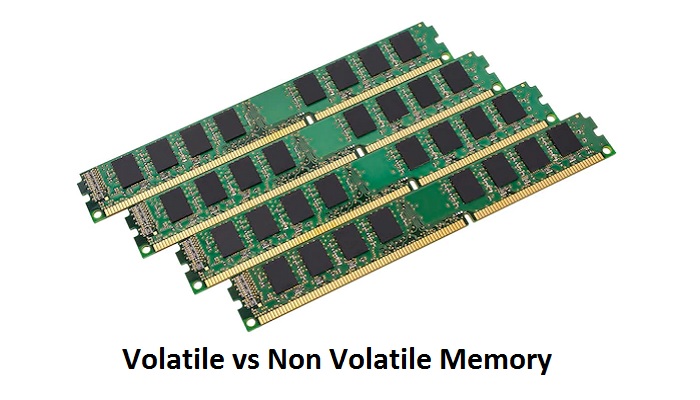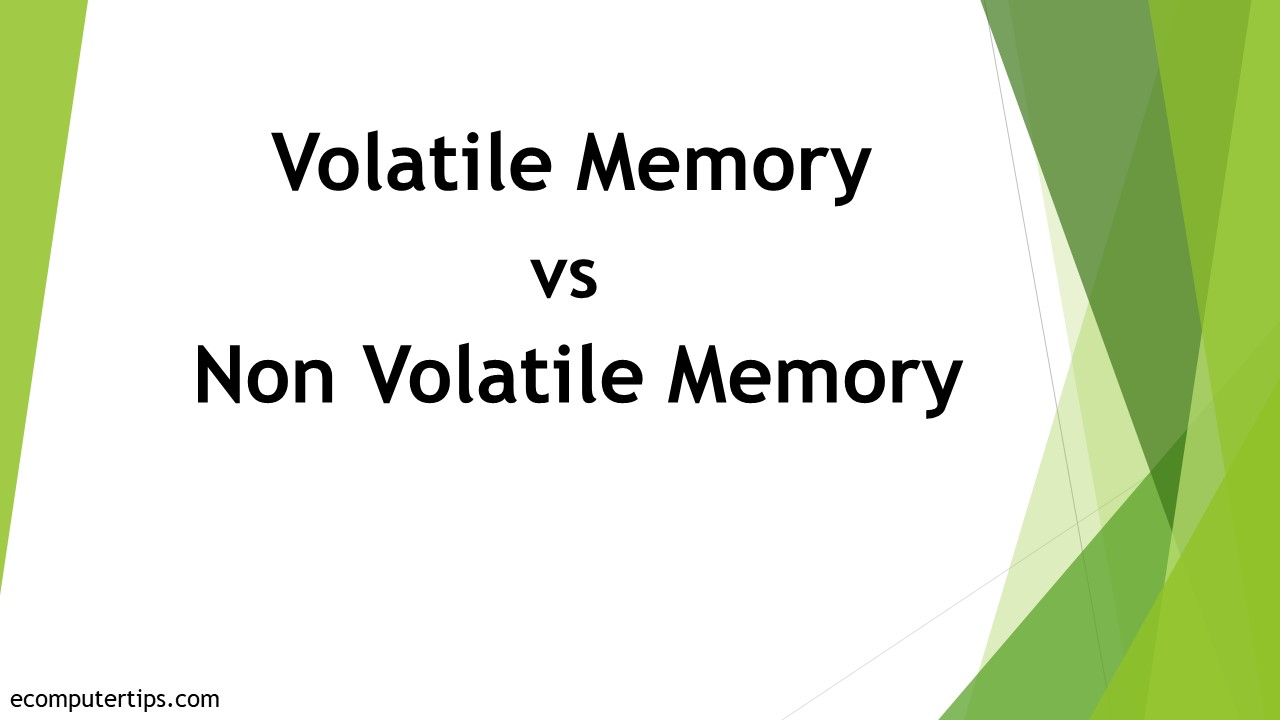One of the main differences between a volatile and a non-volatile memory is that the former loses all the data stored in it very quickly when the power is cut off while the latter retains it even after that.
There are lots of other differences between a volatile and a non-volatile memory which is good to know for any user but sadly, apart from the basic differences, these are not known to the users.
In This Article
KEY TAKEAWAYS
- A volatile memory is that which is used as the primary memory in a computer.
- It is actually in the volatile memory that the actual processing or manipulation of data by the Central Processing Unit or the CPU happens.
- A non-volatile memory is primarily used as a storage drive because it can retain data and information in it even without power supply.
Volatile vs Non Volatile Memory – The 14 Differences

1. Used as
A volatile memory is used as a primary memory and a temporary storage medium. This is because without the data that is made available by the volatile memory, the computer, especially the processor, cannot work.
On the other hand, a non-volatile memory is used as the secondary memory and a permanent storage medium, which is also known as ‘Storage Drives.’
2. Data Type Stored
Typically, a volatile memory stores only that data of the operations that are performed by the CPU currently or in real time.
On the other hand, the non-volatile memory can store any type of data in it permanently.
3. Data Transfer Rates
A volatile memory is pretty fast in transferring data and a good DDR4 memory can reach a speed in excess of 25 GB/s.
In comparison, even the best and the costliest of Solid State Drives or SSDs such as the Gen 4 NVMe can attain a speed just a tad over 5 GB/s only. And, as for the HDDs or Hard Disk Drives on the other hand, the speed is in MBs of merely about 200 MB/s!
4. Ease in Data Transfer
Data can be transferred from and to a volatile memory much more easily than in a non-volatile memory.
On the other hand, data transfer in a non-volatile memory is usually quite difficult.
5. Data Retention
The volatile memory can retain the data in it only till the time power is supplied to it.
On the other hand, the non-volatile memory can retain data and information in it even when the system is turned off or the power supply is cut off.
6. Data Manipulation and Processing
The CPU of the computer accesses the data stored in the volatile memory first to process or manipulate there.
On the other hand, in the non-volatile memory the data is copied to the RAM or Random Access Memory first and then it is processed or manipulated there.
7. Data Holding Capacity
The data holding capacity of the volatile memory is usually very small and the maximum capacity can reach up to a few Gigabytes.
On the other hand, the data holding capacity of the non-volatile memory is quite large in comparison and the maximum capacity can reach up to several Terabytes.
8. Operations Performed
In a volatile memory usually both read and write operations are performed.
On the other hand, in a non-volatile memory only read operation is carried out which is why ROM is the best example of this type of memory.
9. The Cost Factor
The volatile memory is considered to be much higher than a non-volatile memory in terms of per unit size.
On the other hand, the cost per unit size of the non-volatile memory is pretty less.
10. Performance Effects
The volatile memory plays a significant role in improving the performance of the overall system with its direct effects.
On the other hand, the ROM of the computer does not have any direct effect on the performance of the system.
11. System Storage Effects
A volatile memory does not affect the storage of the system because data is stored in it temporarily.
On the other hand, a non-volatile memory surely affects the storage capacity of the device since the data is stored in it permanently.
12. Access to Data
The process is allowed to have direct access to the data stored in the volatile memory.
On the other hand, the processor is not allowed to have direct access to the data stored in a non-volatile memory.
13. Location
The chips of RAM are usually installed onto the memory slot.
On the other hand, the non-volatile memory chips are usually located onto the motherboard of the computer system.
14. Power Consumption
The volatile memory consumes much less power during operation as compared to the hard drives.
On the other hand, the hard disk and other non-volatile memory drives usually consume a lot more power than the volatile memory.
Which is More Useful – Volatile or Non Volatile Memory?

Ideally, for any computer to perform well, both volatile as well as non-volatile memory is required.
This is said in spite of the fact that both of these two types of memories differ quite remarkably as it is evident from the list of their differences mentioned above.
It is very hard, if not impossible, to deny that both volatile and non-volatile memory play a significant role in the operation of a computer.
These devices will hardly allow you to use social media apps, listen to music, access a written document or do any other thing smoothly while using them if they lack any one of these two different types of storage.
A few examples of volatile and non-volatile memory will make things a bit clearer to you in terms of their respective utility.
For example, a volatile memory could be:
- The RAM, which acts as the primary memory for data that is needed to be processed and manipulated and may come with a speed of up to 25.6 GB/s at 3200 MHz for the DDR4 variant and
- The cache, which is the most expensive memory placed very close to the CPU in a computer and operates at a lightning speed anywhere between 10 and 100 times faster in comparison to the RAM.
On the other hand, a few examples of a non-volatile memory would be:
- Hard Disk Drives, which is the most common storage medium for large amounts of data
- Solid State Drives, which is a faster storage medium that help in improving the performance of a computer drastically
- ROM or Read Only Memory, which stores data in it but does not allow any modifications made in it
- USB drives or Flash drives, which are both fast and portable and
- Compact Disks, Digital Versatile Disks and Blu-ray disks that are relatively slow portable storage media.
It can be said that the volatile memory is more useful simply for the fact that a computer cannot start working without it since the processor needs to find the necessary data for it in here.
On the other hand, looking at it from a different perspective, when you perform any type of task on your computer whether it is copying and pasting a file, playing a song or watching a movie, the computer first has to fetch for it in the non-volatile hard drive and store in the volatile RAM for further processing.
However, when you turn the system off abruptly while watching a movie or there is a power failure that causes the computer to shut down suddenly, it will not start from where it was left off the next time.
This is because the movie, the media player, and any other thing that was open in the background while you were watching the movie will also be turned off.
These will not be returned back to their earlier state when you start the system once again.
This means that all the temporary data with regards to all these things will be removed from the RAM while you shut down the computer but the hard disk will still have the movie.
In that case, the operating system will have to start everything all over again right from the scratch.
Therefore, if you consider both the scenarios together, both a volatile and a non-volatile memory are useful for a computer to function properly.
Conclusion
So, now you know after reading this article that a volatile and a non-volatile memory has a lot of different features apart from the fact that the former loses its data when power is cut off while the latter does not.
Based on this knowledge it will surely be useful for you to make a choice, if you have to.